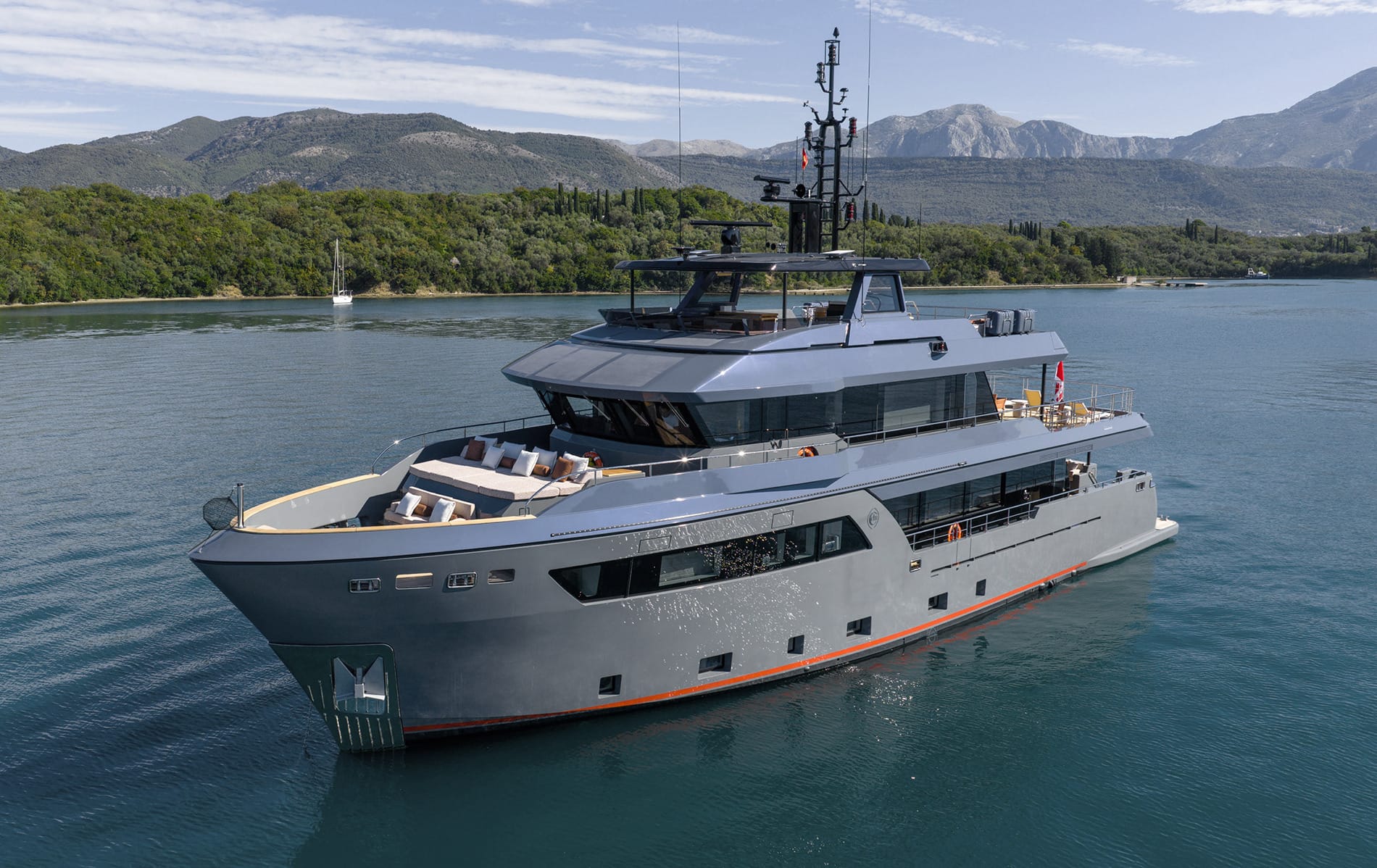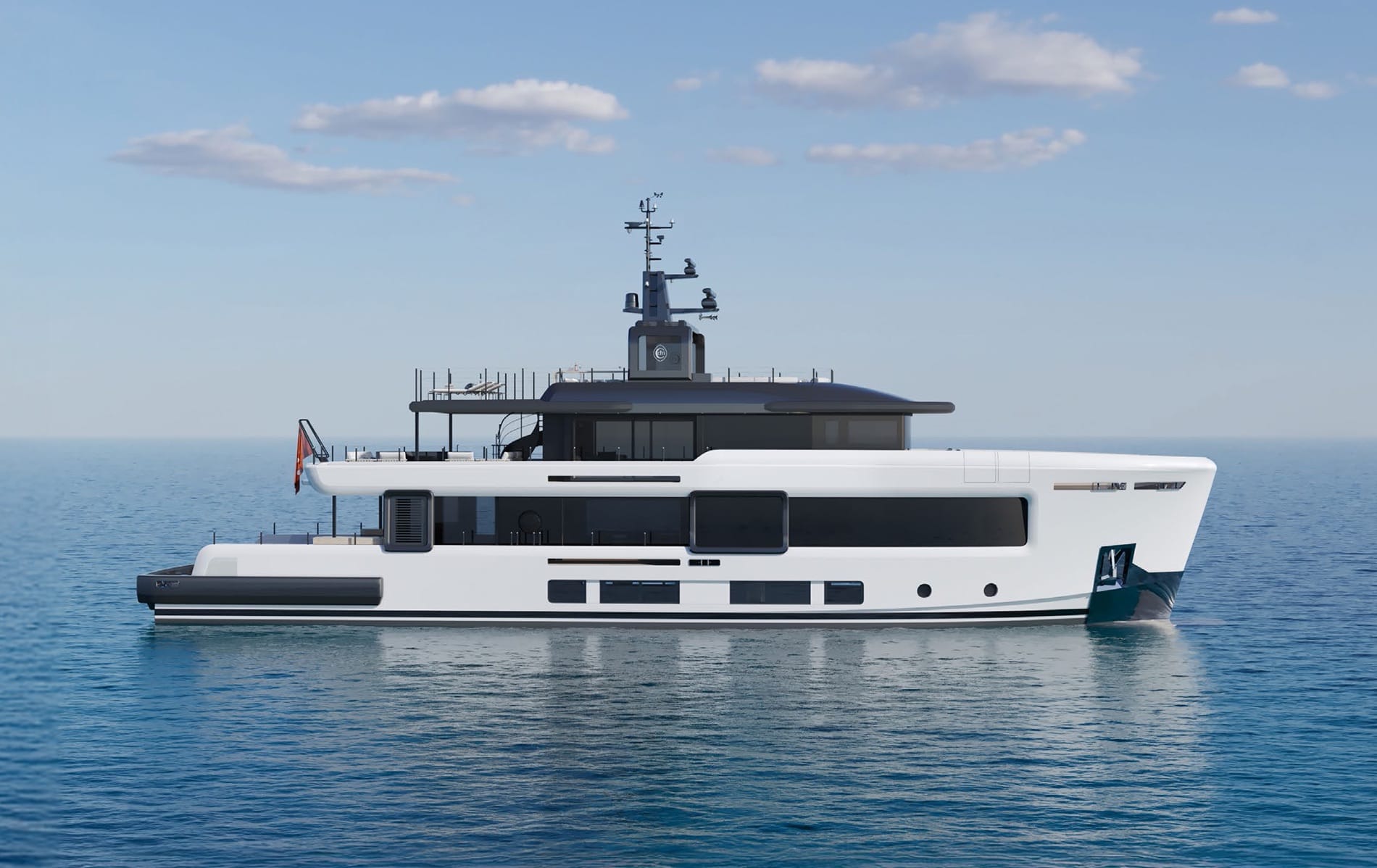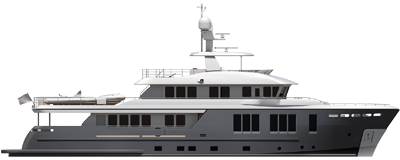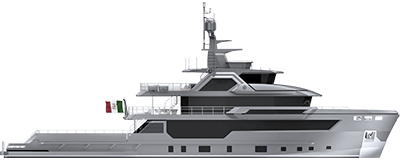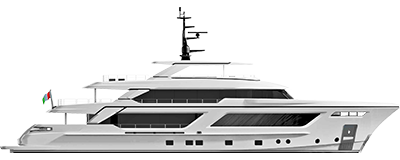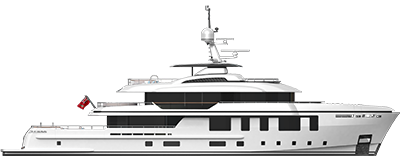Natural
selection
Specialising in custom-designed yachts for value and image-conscious buyers, two-year-old yard Cantiere delle Marche has quickly gained a well-earned global reputation for quality, as Diane M. Byrne discovers when she inspects the impressive new percheron.
To start a yacht building business in the midst of the worst economic recession of recent times may seem like madness. But, as the saying goes, sometimes there’s method to the madness. In the case of Cantiere delle Marche (pronounced ‘mark’), that method is filling a mostly untapped niche, specifically 20-to-45-metre metal displacement yachts meant to go globetrotting on their own bottom. With the 26.1-metre Percheron, a brawny beauty with a cruising itinerary that will surely make many owners envious, Cantiere delle Marche is proving it’s as sane as its yachts are sober.
In 2010, the Cecchini family, well established in commercial shipbuilding in Italy, became interested in branching out into yacht construction. It owned a facility in Ancona that CRN had initially leased but was no longer occupying, due to the economic downturn. Skilled construction and engineering teams were available, some of whom had worked with the Cecchinis for a few decades. The family then needed someone well versed in the superyacht market to lead the efforts. They tapped Vasco Buonpensiere, who had spent five years as brand manager for CRN.
Recruited as Cantiere delle Marche‘s sales and marketing director, Buonpensiere, along with the management team, undertook an analysis of the industry at the time. Obviously, new build sales were far below levels of the recent past, but Buonpensiere saw that the people who were still spending were the so-called ‘old money’, and they were true adventurers. In analysing what models ‘spoke’ to these buyers, Buonpensiere saw these yachtsmen gravitating toward yachts with high quality and lower fuel consumption, and therefore a sense of value for their money.”
Inspired by Charles Darwin, the design’s ‘fitness’, durability and hardiness are immediately apparent.
Once Cantiere delle Marche could marry those factors to a purposeful design and engineering package, Buonpensiere could present proposals to potential clients. All that was needed was a model name. The selection of the name ‘Darwin’ – with Percheron being a Darwin 86 – was no accident.
“We have the same philosophy,” Buonpensiere says, referring to evolutionist Charles Darwin. “It’s not the strongest, but the fittest.” To be among the fittest in terms of build quality, Cantiere delle Marche doesn’t feel it’s enough to just meet classification standards. It overbuilds its yachts, using 12-millimetre steel instead of five-millimetre, for example, and cupronickel piping instead of PVC. It also proudly points to the use of independent rudders, as seen on commercial ships.
The over-construction isn‘t lost on the owners of Percheron or the crew, given what occurred last September when she was between Sicily and Corsica. In fact, the crew shot video from the wheelhouse and embedded it in the blog they’ve been maintaining since the yacht left the shipyard last year. They blogged, ”Sailing in 60-knot winds, three-metre waves - having come from a fibreglass-hulled boat, in these conditions we would be seeking the nearest anchorage for safety, but not in the Darwin 86.”
Few people would ever describe those conditions as “exciting”, but this crew did, adding that “nothing went wrong or got damaged, even after about four hours of battering.
Challenging conditions like these might not be the best indicator of a yacht’s fuel consumption, but for a purpose-built world traveller like Percheron, they reveal another key part of her story. Halfway through their transatlantic crossing in anticipation of the Fort Lauderdale International Boat Show last October, the crew blogged: “Our CAT engines are originally born with 800hp each, but intentionally are restricted to 385hp each. Therefore, we are able to cruise at 100 per cent load for an unlimited amount of time. They are heavy duty working engines that are manufactured for this purpose. All you’d expect is to burn more fuel, from the current 40-litres-each engine to 70/75 litres each.”
Percheron was able to do this while regularly encountering three- or four-metre seas and 30-knot winds, sometimes even higher, throughout the trip. Then, upon arriving in Fort Lauderdale, the captain wrote: “I’m very happy with Percheron’s performance over the Atlantic, 14 days non-stop cruising and not one problem on board. All systems worked fantastically! Overall, we burnt 31,000 litres of fuel, leaving us 11,000 litres, which allows for an extra four to five days cruising. Therefore we arrived with a very comfortable margin.”
Stalwart construction and impressive fuel burn can, of course, only go so far in convincing the yacht-buying public to take a second look. Buonpensiere readily admits it’s equally important for owners to feel they have something they can show off. Cantiere delle Marche has subcontractors who, like many Italian firms, do lovely interior work, executed around the customisation that owners are invited to make.
Now, you might think that Percheron’s 26.1-metre LOA leaves little room for innovation, but there are some truly personal touches that make this yacht a great example of what can happen when forward-thinking parties work together.
Let’s start with the saloon. This living area and the dining area are open to one another, just as you’d find on countless other similar-size yachts. But to stop there would be a mistake, because you’d miss the fact that a buffet-like area to starboard is also a chart table. These are owners who have dreamed of cruising the world for some time, so naturally they’re interested in learning everything they can about where they’re going, and sharing it with others.
Speaking of sharing the adventures, the owners are the parents of three small children, who are accompanying them on cruises. (Talk about the education of a lifetime!) Percheron therefore has a kids’ cabin among the two guest accommodations below decks, which is fitted with three berths: a pair of over-under beds, and one single. All the berths are against the walls, opening up floor space for playtime. To make things easier at the end of a busy day of play on the beach, the ensuite bath in their stateroom includes a tub large enough for all three.
The master stateroom aboard Percheron is also below decks. It has all-drawer stowage, instead of a walk-in wardrobe, at the owners’ request. A sliding glass door closes off the master bath from the sleeping area for privacy, yet still lets light in to brighten the room.
Certainly this stateroom could have gone on deck, but that would have been impractical, given their young children. Plus, it would have prevented Percheron from showing what makes the Darwin series one of the most crew-friendly models around, particularly given that it’s much smaller than the 50-metre range. The crew of three, plus the captain, all have their cabins forward on the main deck, steps away from the galley (with a side-deck door ideal for loading provisions) and separate crew’s mess.
The family, including the children, are welcome in the mess. And besides, the seeming lack of more main deck space for the owners to use isn’t a loss in their eyes. They’re too busy watching shorelines approach from other places, like the wheelhouse’s observation settee. They can even head down to the bow, where Percheron’s sides come up to about shoulder height on the average woman - high enough, at the owners’ request, to keep the kids safe.
While the kids and their parents are enjoying the southeastern United States and nearby islands before eventually heading off to exotic climes like the Galapagos, Cantiere delle Marche continues work on two other Darwins. A Darwin 86 and a Darwin 96 are both being delivered this year, and at time of press, early production work was underway on two of its newest models: a Nauta Air 86 and Nauta Air 88, so-named because they’ve been designed by Nauta Yacht Design.
In fact, Joshua Lee, managing director of Lee Marine, signed a Nauta Air 86 for one of his clients just months after his company became the exclusive agent in China, Southeast Asia, and Australia. He explains that the yacht was commissioned by “a very experienced buyer who could not find a yard to listen to his specific requests.” That was until the owner met this team. As for Lee signing on as the representative, he says it was an easy decision.
While he’d known Buonpensiere for a few years, he says industry colleagues had circulated the shipyard’s range via email, and he was impressed. “Not many other builders offer true custom expedition yachts in steel and alloy,” Lee explains. “The ones that do are very successful because the boats offer so much in terms of range as the world gets smaller and smaller.
“CDM is different for so many reasons, but if I had to list a few, it would be the fact they treat clients as the shipyard’s major asset, and as a result listen and implement their every requirement. It’s also a small ownership model with great experience and passion, not to mention the boats are unbelievable in design and quality.”
Those qualities help to explain why this two-year-old shipyard signed seven contracts in 2012, in spite of the ongoing effects of the global recession. Or, perhaps the downturn is somehow responsible for their success, because Cantiere delle Marche has made a mark where few others have tread?
“To tell you the truth, I’ve never been worried about it,” Buonpensiere says. “I’ve always slept well over what we’re doing.”

